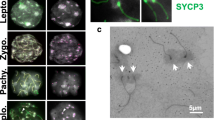Abstract
Terminal associations occur commonly between meiotic homologues of the two smallest (S10, S11) chromosomes in the northern race of Cryptobothrus chrysophorus when they are either heterozygous or homozygous for distal supernumerary heterochromatic segments. A detailed examination of the origin and behaviour of these associations provides convincing evidence that they are non-chiasmate in character and so cannot be explained by either pseudoterminalisation or terminalisation. The same is true of the terminal associations involved in the persistent pseudomultiples that develop between non-homologues of Heteropternis obscurella when one or both of these carry distal heterochromatic segments. In both situations the C-bands involved in such terminal associations are entire and are never interrupted by non-banded material. In Cryptobothrus, similar associations can also develop between centromere regions when these are heterozygous or homozygous for proximal supernumerary heterochromatic segments.
Similar content being viewed by others
References
Ceremeno MC, Orellana J, Lacadena JR (1984) Evidence of non-chiasmate bonds at metaphase I in inbred rye. Can J Genet Cytol 26:409–414
Darlington CD (1932) Recent advances in cytology. Churchill, London
De Larveng L, Lee BH (1984) Polytene chromosomal variability of Bilobella aurantica (Collembola) from a Sainte Baume population (France). Caryologia 37:51–67
John B (1976) Myths and mechanisms of meiosis. Chromosoma 54:295–325
John B, Claridge (1974) Chromosome variation in British populations of Oncopsis (Hemiptera: Cicadellidae). Chromosoma 46:77–89
John B, King M (1977) Heterochromatin variation in Cryptobothrus chrysophorus. II. Patterns of C-banding. Chromosoma 65:59–79
John B, King M (1982) Meiotic effects of supernumerary heterochromatin in Heteropternis obscurella. Chromosoma 85:39–65
John B, King M (1985) The interrelationship between heterochromatin distribution and chiasma distribution. Genetica (in press)
Jones GH (1978) Giemsa C-banding of rye meiotic chromosomes and the nature of “terminal chiasmata”. Chromosoma 66:45–57
Jones GH, Tease C (1984) Analysis of exchanges in differentially stained meiotic chromosomes of Locusta migratoria after BrdU substitution and FPG staining. IV. The nature of ‘terminal associations’. Chromosoma 89:33–36
Kanda N, Kato H (1980) Analysis of crossing over in mouse meiotic cells by BrdU labelling technique. Chromosoma 78:113–121
Tease C, Jones GH (1978) Analysis of exchanges in differentially stained meiotic chromosomes of Locusta migratoria after BrdU substitution and FPG staining. I. Crossover exchanges in monochiasmate bivalents. Chromosoma 69:163–178
Author information
Authors and Affiliations
Rights and permissions
About this article
Cite this article
John, B., King, M. Pseudoterminalisation, terminalisation, and non-chiasmate modes of terminal association. Chromosoma 92, 89–99 (1985). https://doi.org/10.1007/BF00328460
Received:
Issue Date:
DOI: https://doi.org/10.1007/BF00328460




